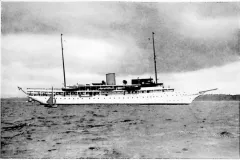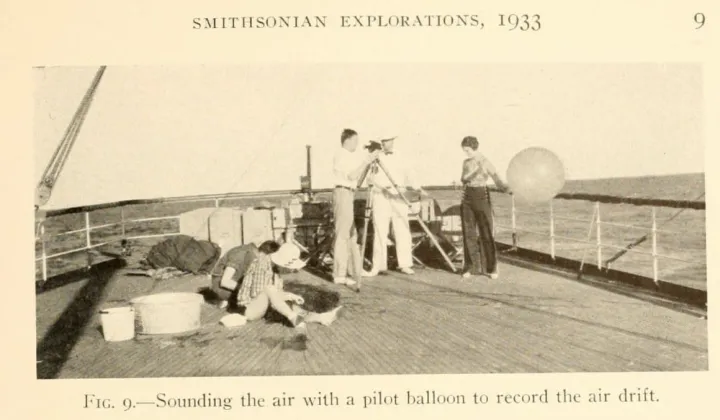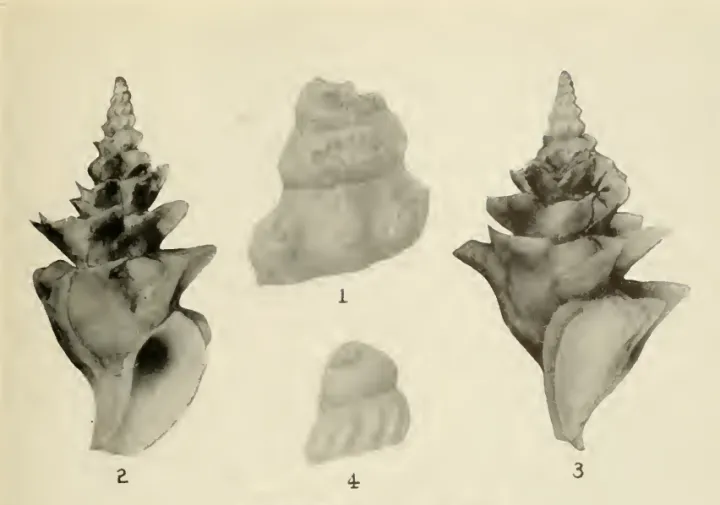Remembering the First Smithsonian Expedition to Puerto Rico

Puerto Rico’s waters just keep surprising scientists. In April 2022, Smithsonian scientists traveled to the south of Puerto Rico to explore life at the bottom of the ocean. The last time the Smithsonian visited the area was close to 100 years ago.
The Smithsonian’s first ever deep-sea expedition off the coast of Puerto Rico was back in 1933. Led by Dr. Paul Bartsch, the Johnson-Smithsonian expedition surveyed an area that was previously unexplored by biologists. They concentrated biological collections at the rim of the deep ocean because of the rough seas and consequently brief time span of the expedition. The expedition also carried out meteorological, physical, and chemical investigations, as well as soundings, by means of the echo-sounding device given and installed by the Navy. The Johnson-Smithsonian expedition was a high-tech operation for its time.
Today, expeditions often use large ships with high resolution video that create maps and show us biological and geological features in the exploration area, as well as additional data about water chemistry, living organisms, and geologic features. The ships measure these with multibeam sonar mapping systems, CTDs (Conductivity, Temperature, and Depth profilers) to measure chemical and physical seawater properties, ROVs (Remotely Operated Vehicle) capable of obtaining high-quality imagery and samples in depths as great as 6,000 meters, and telepresence technologies that allow scientists with many different areas of expertise to observe and interact with exploration activities despite being thousands of miles from the ship.
Back in the 1930s, the research vessels were a little different. Often, scientists used whatever boat was available. This expedition was sponsored by Mr. Eldrige R. Johnson, a wealthy business owner from Philadelphia who placed his beautiful yacht Caroline at the disposal of the Smithsonian Institution and equipped her with the instruments necessary for the work. Thanks to this yacht, which had a length of roughly 279 feet, a beam height of 38 feet, and a 50-ton Sperry gyrostabilizer (which keeps the yacht almost on an even keel at all times), the team was able to keep working even though the water was rough for most of their voyage. During their month on the water, they only encountered two days of calm seas.
From January 30 to March 9, Bartsch, Johnson, the crew, and a few guests traveled along the north of Puerto Rico, about 5 miles off Punta Boca Juana. They used 35-foot mesh otter trawls, extremely heavy bottom-fishing gear that plows the ocean floor as it moves, creating furrows and crushing, burying, and exposing marine life. In total there were 109 stations where they lowered trawls at different areas and depths. Discoveries included sea lilies, three species of pteropod (sea butterflies), umbellula sea pens, sea snails, corals, brittle stars, and scaphopods, a group of mollusks with a long shell resembling an elephant tusk.
One scaphopod species, Dentalium (Episiphon) Johnsoni Emerson, had never been found before. It is a relatively large species of scaphopod that dwarfs most others in the same subgenus—no representative described from the Atlantic Ocean reaches the large size of this species. In total, the expedition procured a total of 17 species, two of which are questionably identified. The specimens are now in the collection of the dDivision of Mollusks at the National Museum of Natural History.
Notably, two women were key to the scientific study during this expedition. At a time where there were very few women in science, it was even rarer that a woman worked on a research vessel. Ena and Florence Douglass contributed greatly to the Johnson-Smithsonian Deep-Sea Expedition. Both were guests of Johnson and collected specimens and managed the sounder equipment.
For years, women had to excel and advocate for themselves in order to be recognized appropriately for their work and dedication. Indeed, behind a lot of men’s successes, there were women working without getting recognition. Eighty-nine years later, a woman named Andrea Quattrini led the next Smithsonian expedition in Puerto Rico, showing just how far science has come since that first expedition.
The Johnson-Smithsonian expedition was scheduled to run for several years, but because of the economic depression and the geopolitical conditions in Europe, Mr. Johnson chose not to sponsor further expeditions. However, Smithsonian scientists continued to explore the ocean and further our understanding of the importance of conserving the ocean and all of the life within it. They’ve continued to rely on improved technology to aid their research and share their findings with the global community. In years to come, it will be exciting to see what future expeditions reveal.



